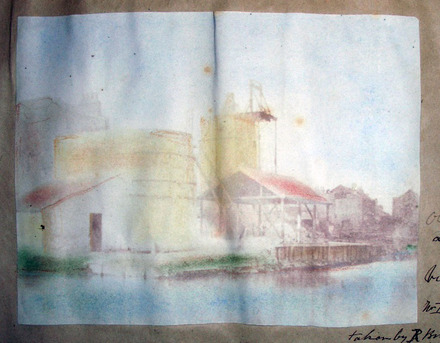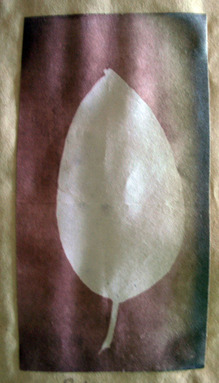Robert Jefferson Bingham (1825-1870), Old Lime Kiln. View on the Regents Canal. Nr Hackney Road from the bridge taken by R. Bingham, coloured by R. Willats about 1848. ca. 1848. Salt paper print with hand coloring; plate 34 in Richard Willats’s photography album, no date. Graphic Arts collection GA 2005.00262.
Bingham was an amateur photographer active both in London and Paris during the 1840s. This photograph was taken in the southeastern London area of Limehouse (named after the lime kilns located at Limekiln Dock). The Limehouse Cut was opened in 1770 to provide a short cut for grain and malt barges, from the River Lea to the River Thames. The Regent’s Canal Company, formed in 1812, built an additional canal to link the Grand Junction at Paddington with Limehouse.
Richard Willats also hand-tinted this calotype (left) taken by a Jersey photographer named Brodie. The Island of Jersey, in the Channel Islands off Normandy, is a British Crown dependency but not part of the United Kingdom or the European Union. By 1840, up to 5,000 English men and women had settled in Jersey.
Princeton’s Willats album holds twenty-one calotypes and salted paper prints taken by Brodie on the Isle of Jersey and another forty-three that can be attributed to him, including genre studies and portraits.


Robert Bingham happens to be here described merely as "an amateur", but even your own major posting three years ago (June 30, 2008) about the Willats' album shows that in the 1840s he was author of manuals on photographic processes.
The life dates given here are those widely published as 1825-1870, but he was baptised at Billesdon (Leicestershire, UK) on 7 March 1824, dying Brussels, Belgium, on 21 Feb 1870.
The records of the London Institution (this was at Finsbury Circus, City of London - not to be confused with the more well known Royal Institution) show that when, in his early 20s as chemical Lab Assistant there from June 1845 to Feb 1848, he earned £1/6s (1 Pound, 6 shillings) per week. So was not in a situation to advance easily in his life - a background that perhaps has unconsciously resulted in him to be easily ignored by historians. But Bingham is a name that should, without any doubt, hold a very significant place in the history of the beginnings of photography.
Just one example: Helmut Gernsheim - like many others - had a closed mind regarding the famous photographs printed in the 'Reports by the Juries' of the great Exhibition of London in 1851. The accepted version was that it must obviously be one of the many perfections of W. H. F. Talbot and his associate Henneman - after all Talbot had been presented with dedicated copies of that work by the Commissioners of the Exhibition. Yet when I had found documentary evidence that the photographs had been printed (and do note it was from glass negatives not paper calotypes) by Robert Bingham in Versailles, France, that was summarily dismissed by Gernsheim (H. Gernsheim, 'Origins of Photography', edition of 1982, p. 207), And to suggest that Talbot was presented with copies of the 'Reports by the Juries' by the official Commissioners just to keep Talbot off their backs regarding his Calotype patent, was almost akin to blasphemy. In contrast, and in such ways, men of achievement like Robert Bingham are ignored.
R. Derek Wood